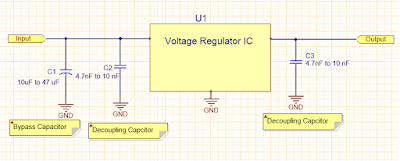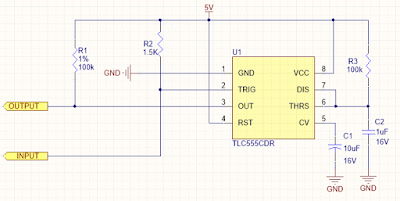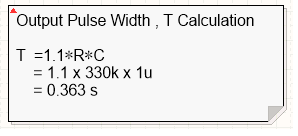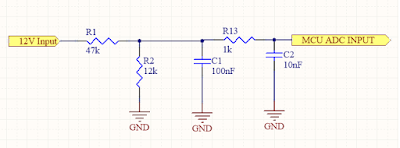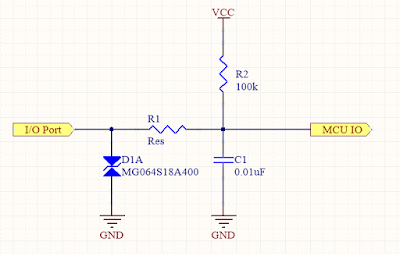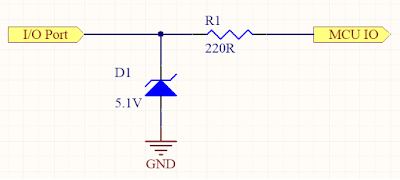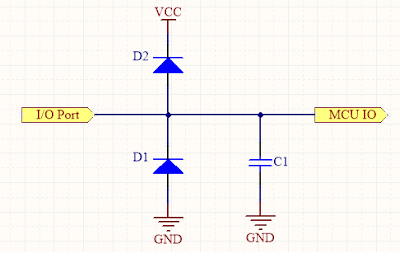Bypass Capacitors
The main function of the bypass capacitor is to create an AC shunt to remove undesirable energy from entering susceptible areas. The bypass capacitor is acting as a high frequency bypass source to reduce the transient circuit demand on the power supply unit. Usually, aluminium or tantalum capacitor is a good choice for bypass capacitors, its value depends on the transient current demand on the PCB, but it is usually in the range of 10 to 47 uF. Larger values are required on the PCB with a large number of integrated circuits, fast switching circuits, and PSUs and having long leads to PCB.
Decoupling Capacitors
During active device switching, the high frequency switching noise created is distributed along the power supply lines. The main function of the decoupling is to provide localised source of DC power for the active devices, thus reducing switching noise propagating across the board and decoupling the noise to ground.
Ideally, the bypass and decoupling should be placed as close as possible to the power supply inlet to help filter high frequency noises. The value of decouupling capacitor is approximately 1/100 or 1/1000 of the bypass capacitor. For better EMC performance, decoupling capacitors should be placed as close as possible to each IC, because trace impedance will reduce the effectiveness of decoupling function.
Creamic capacitors are usually selected for decoupling; choosing the value depends on the rise and fall times of the fastest signal. For example, with a 33 MHz clock frequency, use 4.7nF to 100nF, with a 100 MHz clock frequency use 10nF.
Apart from the capacitance value when choosing the decoupling capacitor, the low ESR of the capacitor also affects its decoupling capabilities. For decoupling, it is preferable to choose capacitors with a ESR value less than 1 ohm.
Tuesday, April 17, 2018
Thursday, April 12, 2018
Logic Inverter with Schmitt Trigger
This circuit can take noisy active low input signal, invert the logic and provide clean Schmitt Trigger output.
Wednesday, April 11, 2018
Soft-Start and Protection Circuit
When the input is below 18 V, Q1 is OFF state allowing C3 to be charged though R3. Thus turning on Q105. Once the input voltage exceed 18 plus two diode drop Volts, Q1 will turn on that discharge C3 and Q105 is OFF.
Once the input goes back below 18 V, Q1 is turn off again. This allows C3 to be charged slowly resulting soft-start at the output.
Tuesday, April 10, 2018
Pulse Width Stretcher using 555 Timer IC
This circuit will invert and stretch the short period active low input signal as below.
Required pulse width can be calculated by using this equation.
Monday, April 9, 2018
Micro-controller Output Protection by Current Limiting
Maximum current = VBE,Q1A / R2 = 0.65 / 33 = 19.7 mA
Sunday, April 8, 2018
High Voltage Monitoring/ Measuring using Microcontroller's ADC input
Voltage divider resistor network is used to step monitored voltage down to the range as necessary for A/D conversion. Passive low-pass filter is used for noise rejection.
Saturday, April 7, 2018
Voltage Doubler Circuit
This circuit will convert AC voltage to large DC output voltage. It will take AC input, convert it to DC and double the voltage to the output.
Reverse Polarity Protection
Zener Voltage = 10 V, Q1-VGS max = +/- 20V
Zener diode, D3 will protect the gate from excessive voltages/ unwanted spikes
By
referring the Gate signal to the ground line, the device is fully turned on when the
battery is applied in the right polarity. For the first start up, the intrinsic body diode
of the MOSFET will conduct, until the channel is switched on in parallel. The Zener
diode will clamp the Gate of the MOSFET to its Zener voltage and protecting it
against overvoltage.
By reverse polarity, the MOSFET will be switched off, because the Gate Source
voltage for this case will be positive (voltage drop over the Zener diode).
Friday, April 6, 2018
Bi-directional Logic Level Shifter
Input = 0V ; VGS > VGS(th) ; FET = ON ; Output = 0V
Input = 3.3V ; VGS < VGS(th) ; FET = OFF ; Output = 5V
Thursday, April 5, 2018
Protecting microcontroller's Inputs
1) Filtering
This circuit can be used to protect I/Os of micro-controller/ processors. D1A is used for Transient Voltage Suppression or ESD protection. R1 acts as current limiting resister as well as low pass filter together with C1. The value of the resistor and the capacitor must be sized so that the micro-controller does not miss any signals.
Rise time of the fastest income edge = 2.2 RC
2) Limiting Current
This circuit limit the input current to 23.2 mA (VZ/R1 = 5.1 / 220).
3) Limiting Voltage
Use schottky diodes with 0.2 Vf for better performance. Once the voltage at I/O pin is greater than VCC by about 0.2V, the top diode will start to conduct. The bottom diode will conduct for voltage less than -0.2V.
Subscribe to:
Posts (Atom)
Ultra-Precise, Current-Sense Amplifier
This ultra-precise current sense amplifier that can measure voltage drops across shunt resistor, R1 over a wide common mode range from 2....

-
Voltage divider resistor network is used to step monitored voltage down to the range as necessary for A/D conversion. Passive low-pass f...
-
Import Changes from Schematics to PCB in Alitum as below. 1) Compile the Project 2) Design >> Import Changes From XXX.PrjPCB 3)Execut...
